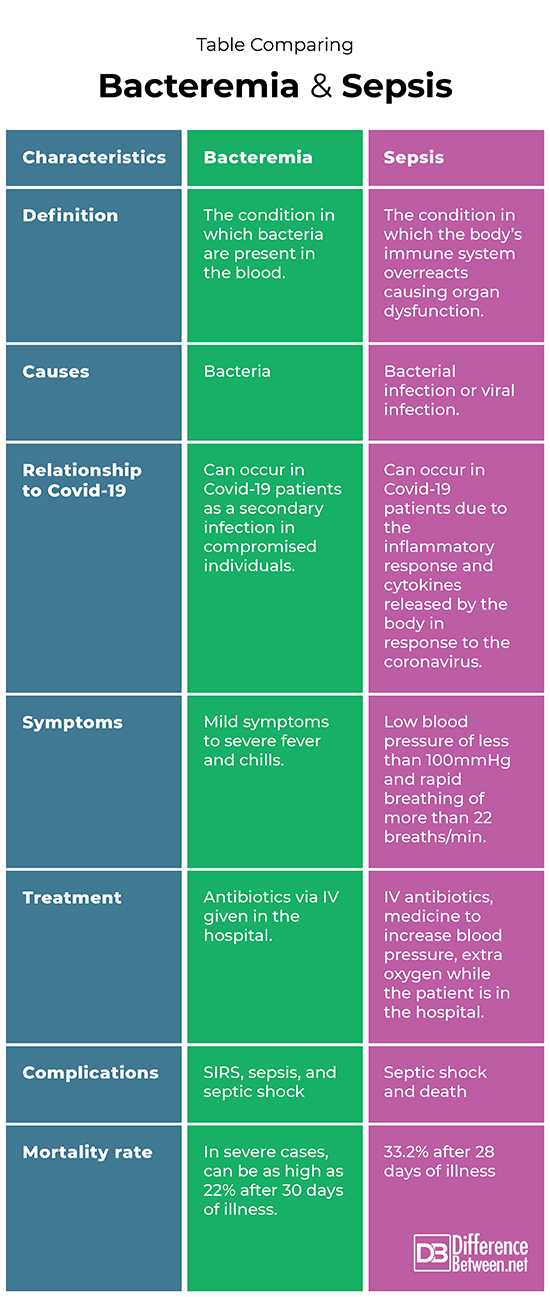Difference Between Bacteremia and Sepsis
Bacteremia is when there are bacteria in the blood. Sepsis is when the immune system response to an infection causes organs to not function properly.

What is Bacteremia?
Definition:
Bacteremia is the term used for the condition in which bacterial organisms are found in the blood stream.
Causes:
Bacteremia is caused by bacteria that spreads into the blood. This can occur as a result of certain procedures such as the presence of an indwelling catheter in the body or an ostomy device. An infection can also occur after a surgical procedure, although efforts are made to reduce the chance of this happening. The organisms most commonly responsible for bacteremia are gram-negative bacteria such as E. coli and Pseudomonas.
Symptoms and diagnosis:
Symptoms of bacteremia can be mild and can manifest as chills and a fever. In a healthy individual, mild cases of bacteremia may show no symptoms and the person may recover without any problems. Diagnosis of bacteremia is made by blood cultures in which bacteria are searched for and , in some cases, a culture may need to be grown. The diagnosis of the specific type of bacterium involved can enable the doctor to choose the best antibiotic.
Treatment:
Treatment of bacteremia involves using antibiotics; the choice of specific types of antibiotics often depends on what organisms the culture shows as being present. In cases of severe bacteremia, antibiotics are often given intravenously (IV) and the patient is placed in the hospital and monitored.
Complications:
Bacteremia can quickly progress to systemic inflammatory response syndrome (SIRS), which can further develop into a condition of sepsis or septic shock, which greatly increases the risk of death to the patient. In the case of Covid-19 patients, bacteremia due to bacterial species such as Staphylococcus aureus can occur as a secondary infection and can greatly complicate the recovery of these patients from coronavirus.

What is Sepsis?
Definition:
Sepsis is an overreaction of the inflammatory response of the body to an infection, resulting in problems with organ function.
Causes:
The causes of sepsis include bacteremia and various infections of the lungs, kidney or other organs of the body. Sepsis can also be caused by viruses, including Covid-19, when cytokine chemicals produced by the immune systemin response to the virus, cause major organ problems. Wounds and burn injuries can also lead to sepsis because bacteria can enter the body easily.
Symptoms and diagnosis:
Symptoms include rapid respiratory rate of 22 breaths per minute or higher, and low systolic blood pressure below 100 mmHg. When sepsis becomes severe the blood pressure drops below 90 mmHg, resulting in compromised blood flow and oxygenation of organs of the body. Diagnosis of sepsis is based on a combination of symptoms including elevated values of C-reactive protein, and white blood cell count. There may also be a decrease in oxygen saturation.
Treatment:
Treatment of sepsis needs to occur rapidly and often includes medication to raise dangerously low blood pressure. Supplemental oxygen may be needed, and antibiotics are routinely given to treat the underlying infection in the case of bacterial-induced sepsis. A person with sepsis needs to be in the hospital and quickly treated to avoid complications.
Complications:
The danger with sepsis is that it can quickly progress to septic shock which has a 40% mortality rate. Septic shock can rapidly result in death due to kidney failure, respiratory failure, or multiple organ failure. This is a danger for Covid-19 patients who are in critical condition in hospital and who may enter a state of sepsis leading to septic shock.
Difference between Bacteremia and Sepsis
Definition
Bacteremia is the condition in which bacteria are present in the blood. Sepsis is the condition in which the body’s immune system overreacts causing organ dysfunction.
Causes
Bacteria are the cause of bacteremia. Bacteria and viruses can be the cause of sepsis.
Relationship to Covid-19
Bacteremia can occur in Covid-19 patients as a secondary infection in compromised individuals. Sepsis can occur in Covid-19 patients because of the inflammatory response and cytokines released by the body in response to the coronavirus.
Symptoms
Mild symptoms to more severe chills and fever can be signs of bacteremia. Low blood pressure and a rapid breathing rate can be signs of sepsis.
Treatment
IV antibiotics are used to treat bacteremia. IV antibiotics, oxygen, and medicine to raise blood pressure are used to treat sepsis.
Complications
Complications of bacteremia include SIRS, sepsis, and septic shock. Complications of sepsis include septic shock and death.
Mortality rate
The mortality rate of severe bacteremia after 30 days of illness is 22%. The mortality rate of sepsis after 28 days of illness is 33.2%.
Table comparing Bacteremia and Sepsis

Summary of Bacteremia Vs. Sepsis
- Bacteremia is bacteria in the blood stream.
- Sepsis is a condition due to the body’s immune system overreacting to an infection.
- Bacteremia is bacteria in the blood stream.
- Sepsis is a condition due to the body’s immune system overreacting to an infection.
- Difference Between Rumination and Regurgitation - June 13, 2024
- Difference Between Pyelectasis and Hydronephrosis - June 4, 2024
- Difference Between Cellulitis and Erysipelas - June 1, 2024
Search DifferenceBetween.net :
References :
[0]Bush, Larry M. “Bacteremia.” Merckmanuals. Merck & Co., 2020, https://www.msdmanuals.com/professional/infectious-diseases/biology-of-infectious-disease/bacteremia
[1]Colantuoni, Antonio, et al. "COVID-19 sepsis and microcirculation dysfunction." Frontiers in physiology 11 (2020): 747.
[2]Maggio, Paul M. “Sepsis and Septic shock.” Merckmanuals. Merck & Co., 2020, https://www.msdmanuals.com/professional/critical-care-medicine/sepsis-and-septic-shock/sepsis-and-septic-shock?query=sepsis
[3]Image credit: https://pixnio.com/free-images/science/microscopy-images/brucellosis-brucella/brucellosis-is-diagnosed-in-a-laboratory-by-finding-brucella-organisms-in-samples-of-blood-or-bone-marrow-550x458.jpg
[4]Image credit: https://commons.wikimedia.org/wiki/File:Sepsis_Steps.png
